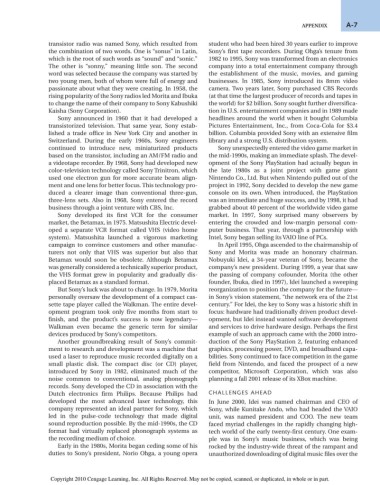Page 673 - Introduction to Business
P. 673
APPENDIX A-7
transistor radio was named Sony, which resulted from student who had been hired 30 years earlier to improve
the combination of two words. One is “sonus” in Latin, Sony’s first tape recorders. During Ohga’s tenure from
which is the root of such words as “sound” and “sonic.” 1982 to 1995, Sony was transformed from an electronics
The other is “sonny,” meaning little son. The second company into a total entertainment company through
word was selected because the company was started by the establishment of the music, movies, and gaming
two young men, both of whom were full of energy and businesses. In 1985, Sony introduced its 8mm video
passionate about what they were creating. In 1958, the camera. Two years later, Sony purchased CBS Records
rising popularity of the Sony radios led Morita and Ibuka (at that time the largest producer of records and tapes in
to change the name of their company to Sony Kabushiki the world) for $2 billion. Sony sought further diversifica-
Kaisha (Sony Corporation). tion in U.S. entertainment companies and in 1989 made
Sony announced in 1960 that it had developed a headlines around the world when it bought Columbia
transistorized television. That same year, Sony estab- Pictures Entertainment, Inc., from Coca-Cola for $3.4
lished a trade office in New York City and another in billion. Columbia provided Sony with an extensive film
Switzerland. During the early 1960s, Sony engineers library and a strong U.S. distribution system.
continued to introduce new, miniaturized products Sony unexpectedly entered the video game market in
based on the transistor, including an AM/FM radio and the mid-1990s, making an immediate splash. The devel-
a videotape recorder. By 1968, Sony had developed new opment of the Sony PlayStation had actually begun in
color-television technology called Sony Trinitron, which the late 1980s as a joint project with game giant
used one electron gun for more accurate beam align- Nintendo Co., Ltd. But when Nintendo pulled out of the
ment and one lens for better focus. This technology pro- project in 1992, Sony decided to develop the new game
duced a clearer image than conventional three-gun, console on its own. When introduced, the PlayStation
three-lens sets. Also in 1968, Sony entered the record was an immediate and huge success, and by 1998, it had
business through a joint venture with CBS, Inc. grabbed about 40 percent of the worldwide video game
Sony developed its first VCR for the consumer market. In 1997, Sony surprised many observers by
market, the Betamax, in 1975. Matsushita Electric devel- entering the crowded and low-margin personal com-
oped a separate VCR format called VHS (video home puter business. That year, through a partnership with
system). Matsushita launched a vigorous marketing Intel, Sony began selling its VAIO line of PCs.
campaign to convince customers and other manufac- In April 1995, Ohga ascended to the chairmanship of
turers not only that VHS was superior but also that Sony and Morita was made an honorary chairman.
Betamax would soon be obsolete. Although Betamax Nobuyuki Idei, a 34-year veteran of Sony, became the
was generally considered a technically superior product, company’s new president. During 1999, a year that saw
the VHS format grew in popularity and gradually dis- the passing of company cofounder, Morita (the other
placed Betamax as a standard format. founder, Ibuka, died in 1997), Idei launched a sweeping
But Sony’s luck was about to change. In 1979, Morita reorganization to position the company for the future—
personally oversaw the development of a compact cas- in Sony’s vision statement, “the network era of the 21st
sette tape player called the Walkman. The entire devel- century.” For Idei, the key to Sony was a historic shift in
opment program took only five months from start to focus: hardware had traditionally driven product devel-
finish, and the product’s success is now legendary— opment, but Idei instead wanted software development
Walkman even became the generic term for similar and services to drive hardware design. Perhaps the first
devices produced by Sony’s competitors. example of such an approach came with the 2000 intro-
Another groundbreaking result of Sony’s commit- duction of the Sony PlayStation 2, featuring enhanced
ment to research and development was a machine that graphics, processing power, DVD, and broadband capa-
used a laser to reproduce music recorded digitally on a bilities. Sony continued to face competition in the game
small plastic disk. The compact disc (or CD) player, field from Nintendo, and faced the prospect of a new
introduced by Sony in 1982, eliminated much of the competitor, Microsoft Corporation, which was also
noise common to conventional, analog phonograph planning a fall 2001 release of its XBox machine.
records. Sony developed the CD in association with the
Dutch electronics firm Philips. Because Philips had CHALLENGES AHEAD
developed the most advanced laser technology, this In June 2000, Idei was named chairman and CEO of
company represented an ideal partner for Sony, which Sony, while Kunitake Ando, who had headed the VAIO
led in the pulse-code technology that made digital unit, was named president and COO. The new team
sound reproduction possible. By the mid-1990s, the CD faced myriad challenges in the rapidly changing high-
format had virtually replaced phonograph systems as tech world of the early twenty-first century. One exam-
the recording medium of choice. ple was in Sony’s music business, which was being
Early in the 1980s, Morita began ceding some of his rocked by the industry-wide threat of the rampant and
duties to Sony’s president, Norio Ohga, a young opera unauthorized downloading of digital music files over the
Copyright 2010 Cengage Learning, Inc. All Rights Reserved. May not be copied, scanned, or duplicated, in whole or in part.

